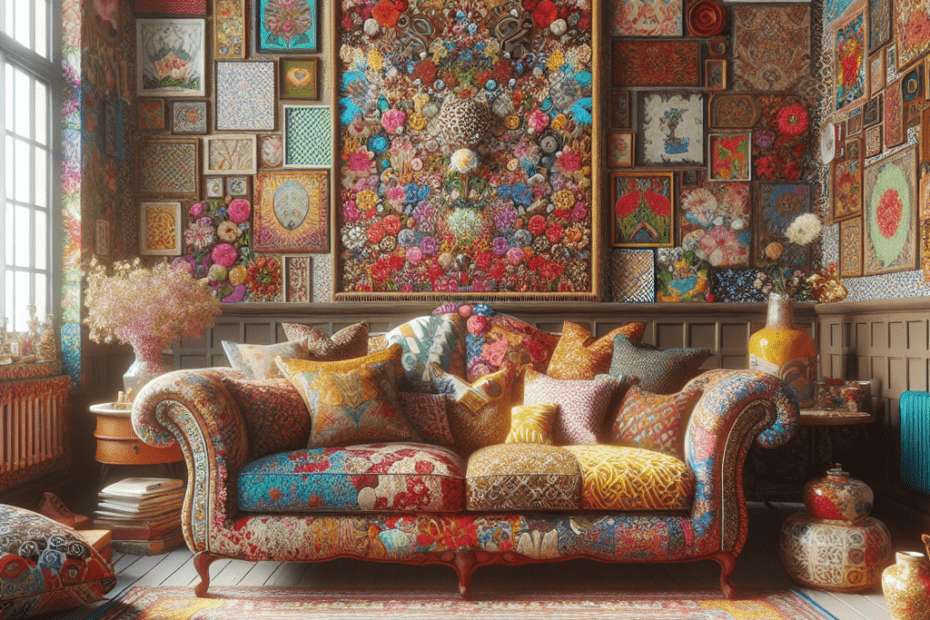“`html
Introduction
In the world of interior design, maximalism has taken the spotlight. They are increasingly embracing bold patterns in maximalism, using them to create spaces that captivate and stimulate. Instead of the minimalist’s “less is more,” maximalists say “more is more.” They thrive on intricate designs, vibrant colors, and diverse textures. This design philosophy celebrates complexity and creativity, allowing designers to experiment with bold patterns that dazzle and enliven any space.
The Rise of Maximalism
Maximalism began to gain popularity as a response to the clean lines and sparse spaces typical of minimalistic design. According to a survey conducted by the American Society of Interior Designers (ASID), the number of interior designers using bold patterns increased by 37% in the last year (Source). Maximalism’s rise is partly due to the increased desire for personal expression within home interiors. People are ready to showcase their individuality, tastes, and stories through intricate and vibrant designs.
The Charm of Bold Patterns
Bold patterns play a crucial role in maximalism. These patterns add depth, interest, and a dynamic sense of movement to a room. They attract attention and create focal points that engage visitors. In maximalist design, bold patterns often appear in wallpapers, upholstery, rugs, and artwork. Utilizing these elements requires a balanced approach to avoid overwhelming the space.
Crafting Harmonious Spaces
Designers face the challenge of blending diverse elements harmoniously in maximalist spaces. According to designers, one effective strategy is to use a consistent color palette across different patterns, ensuring that even the boldest designs seem part of a curated collection rather than a chaotic assembly. This not only helps create a sense of uniformity but also allows patterns to play off each other without clashing.
Table: Popular Bold Patterns in Maximalism
| Pattern Type | Description | Usage Example |
|---|---|---|
| Geometric | Features shapes like circles, squares, and lines in vibrant colors. | Wallpaper, tiles |
| Floral | Incorporates floral designs ranging from stylized to realistic. | Upholstery, curtains |
| Animal Print | Mimics the appearance of animal skins or textures. | Rugs, upholstered chairs |
Implementation Techniques
They have several methods to implement bold patterns within maximalist spaces. Layering is a popular technique, where patterns are stacked in a way that complements rather than competes. For example, a large floral pattern on a wall could be layered with a smaller geometric pattern on a cushion, enhancing the overall aesthetic.
Another method is “zoning” different areas within a space. Here, varying patterns help define separate areas, each offering a distinct visual experience while contributing to a unified design narrative. Through zoning, distinct boundaries are created not only using physical dividers but also through the strategic application of patterns.
The Psychological Impact
They understand that patterns can affect mood and perception. Bold patterns evoke emotions and can energize or calm occupants, depending on the design and color scheme. According to a study published in the Journal of Environmental Psychology, engaging environments like those featuring bold patterns can encourage creativity and reduce stress (Source).
Key Takeaways
- Maximalism highlights personal expression through intricate, vibrant designs.
- Bold patterns are essential in crafting intriguing and dynamic spaces.
- Increased use of patterns allows for creativity and individuality in home design.
- Consistent color palettes ensure harmony among diverse designs.
- Patterns can influence the mood and atmosphere within a space.
FAQ
- What defines maximalism in interior design? Maximalism is an interior design style characterized by the use of bold colors, diverse patterns, and a mix of textures, embracing a “more is more” philosophy.
- How do designers ensure bold patterns don’t clash? They maintain a consistent color palette to unify patterns and complement instead of competing, ensuring harmony.
- Where are bold patterns typically used in a room? Bold patterns can be featured in wallpapers, upholstery, rugs, artwork, and decorative pieces.
- Do bold patterns suit small spaces? Yes, bold patterns can work in small spaces by creating depth and interest, though careful planning is crucial to avoid overwhelming the area.
- Why are bold patterns emotionally impactful? Bold patterns capture attention and can evoke energetic or calming emotions depending on their use, contributing to the overall mood of the space.
“`
